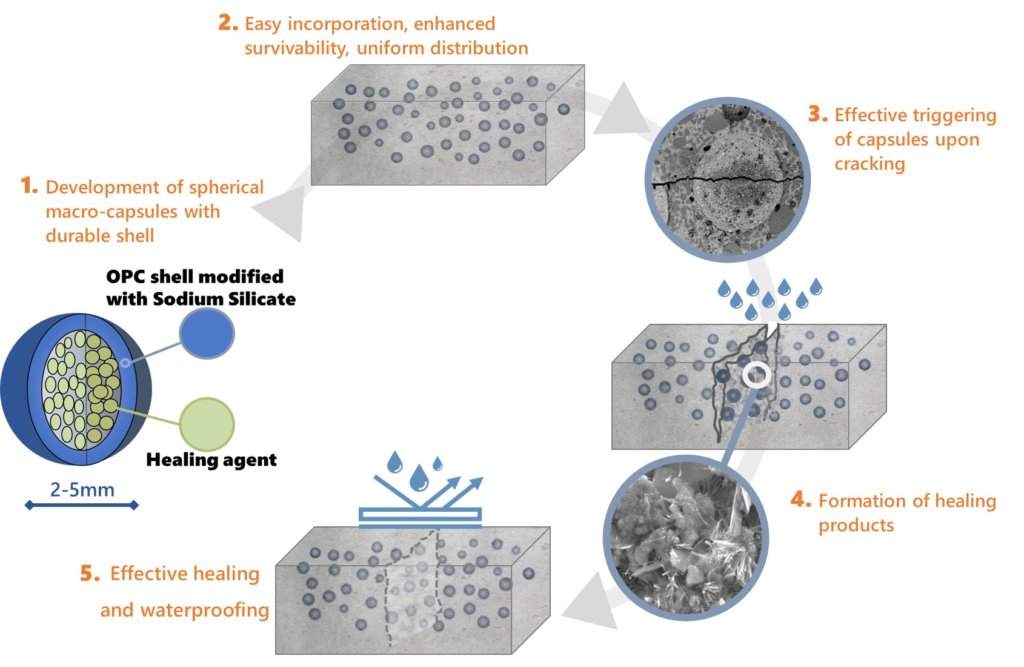Self-healing Mortars and Cement-based Composites
Historic mortars exhibit in many cases remarkable durability over time, which has been attributed to their ability of
Self-healing is a research topic with increased research, commercial and social interest.
Self-healing refers to any process by the material itself involving the recovery and hence improvement of a performance after damage. In the case of lime and cement-based mortars, autogenic self-healing process can take place as a natural mechanism, and heal cracks up to 80 microns without these materials being specifically designed for this. This ability explains partially the superior performance of archaeological lime-based mortars, Roman concrete and historic cements.
Today, self-healing cementitious materials comprise an emerging technology that aim to extend the service life of critical infrastructure and reduce the environmental impact of the construction industry.
CCM group research is focused on capsule-based self-healing additives for cement-based and lime-based conservation/restoration mixtures. The encapsulation approach has attracted the research and industry interest, due to the potential of long-term healing efficiency of the healing agent inside a durable shell that ensures the long-term availability and reactivity. Compared to autogenous healing, encapsulated healing agents can heal larger cracks -up to 500 microns-, while capsule-based cements can provide timeless healing ability of the material.
The main parameters studied in lad concern the design and performance characteristics of capsules, in order to ensure the efficient integration in cement mixtures, maximize the possibility of releasing the healing agent during crack propagation, as well as enhance the healing capacity of the composite, avoiding to diminish the initial performance of the cement matrix.

See more about self-healing innovations in the video below
FEATURED PUBLICATIONS
- Papaioannou, S., Amenta, M., Kilikoglou, V., Gournis, D., Karatasios, I., Synthesis and integration of cement-based capsules modified with sodium silicate for developing self-healing cements (2022) Construction and Building Materials, 316, DOI: 10.1016/j.conbuildmat.2021.125803
- Amenta, M., Papaioannou, S., Kilikoglou, V., Karatasios, I., Morphological and Chemical Characterization of Self-Healing Products in MgO Concrete (2022) RILEM Bookseries, 34, pp. 335-348, DOI: 10.1007/978-3-030-76465-4_30
- Amenta, M., Metaxa, Z.S., Papaioannou, S., Katsiotis, M.S., Kilikoglou, V., Kourkoulis, S.K., Karatasios, I., Quantitative evaluation of self-healing capacity in cementitious materials (2021) Material Design and Processing Communications, 3 (3), DOI: 10.1002/mdp2.152
- Litina, C., Bumanis, G., Anglani, G., Dudek, M., Maddalena, R., Amenta, M., Papaioannou, S., Pérez, G., Calvo, J.L.G., Asensio, E., Cobos, R.B., Pinto, F.T., Augonis, A., Davies, R., Guerrero, A., Moreno, M.S., Stryszewska, T., Karatasios, I., Tulliani, J.-M., Antonaci, P., Bajare, D., Al‐tabbaa, A., Evaluation of methodologies for assessing self‐healing performance of concrete with mineral expansive agents: An interlaboratory study (2021) Materials, 14 (8), DOI: 10.3390/ma14082024
- Papaioannou, S., Amenta, M., Kilikoglou, V., Gournis, D., Karatasios, I., Critical aspects in the development and integration of encapsulated healing agents in cement and concrete (2021) Journal of Advanced Concrete Technology, 19 (4), pp. 301-320, DOI: 10.3151/JACT.19.301
- Amenta, M., Karatasios, I., Psycharis, V., Maravelaki, P., Kilikoglou, V., The leaching mechanism of hydraulic mortars as part of autogenic self-healing process (2020) Journal of Cultural Heritage, 46, pp. 1-10, DOI: 10.1016/j.culher.2020.06.012